





It is with great pleasure and pride that we celebrate a momentous milestone in our shared history - the 60th anniversary of the Nantucket Conservation Foundation. Six decades ago, a group of visionary individuals came together with a shared commitment to preserve the natural beauty and ecological diversity of this island we call home. Since then, we have tirelessly worked to protect and steward our precious landscapes, ensuring that Nantucket remains a haven for biodiversity and a source of inspiration for generations to come.
As we celebrate this significant anniversary, we look back with gratitude for the unwavering support from our community, dedicated volunteers, and generous donors who have made our achievements possible. Together, we have safeguarded critical habitats, restored ecosystems, and educated countless individuals about the importance of conservation.
We are thrilled to announce a significant development in the journey of the Nantucket Conservation Foundation. After careful consideration, collaboration, and thoughtful planning, we are unveiling our new strategic priorities designed to propel us towards even greater success in environmental conservation. You will find these initiatives within these pages, along with our newly adopted mission statement that highlights our growth.

Looking forward, I am thrilled to share with you our renewed commitment to advancing conservation on Nantucket. Our team is more energized than ever to embark on exciting initiatives that will shape the future of our island. One standout project that fills us with enthusiasm is the Windswept Bog Wetland Restoration. This keystone project is the Foundation’s largest restoration project to-date and will contribute to a healthier, more resilient ecosystem while also setting the stage for future restoration endeavors.
As we move forward, I invite you to join us in this exciting chapter of our conservation journey. Your continued support, whether through volunteering, giving, or spreading awareness, is invaluable in ensuring the success of our initiatives.
Together, we can make a lasting impact and leave a legacy of environmental stewardship for generations to come. Thank you for being an integral part of the Nantucket Conservation Foundation’s story. Here’s to 60 years of conservation success and to many more ahead.
With appreciation,

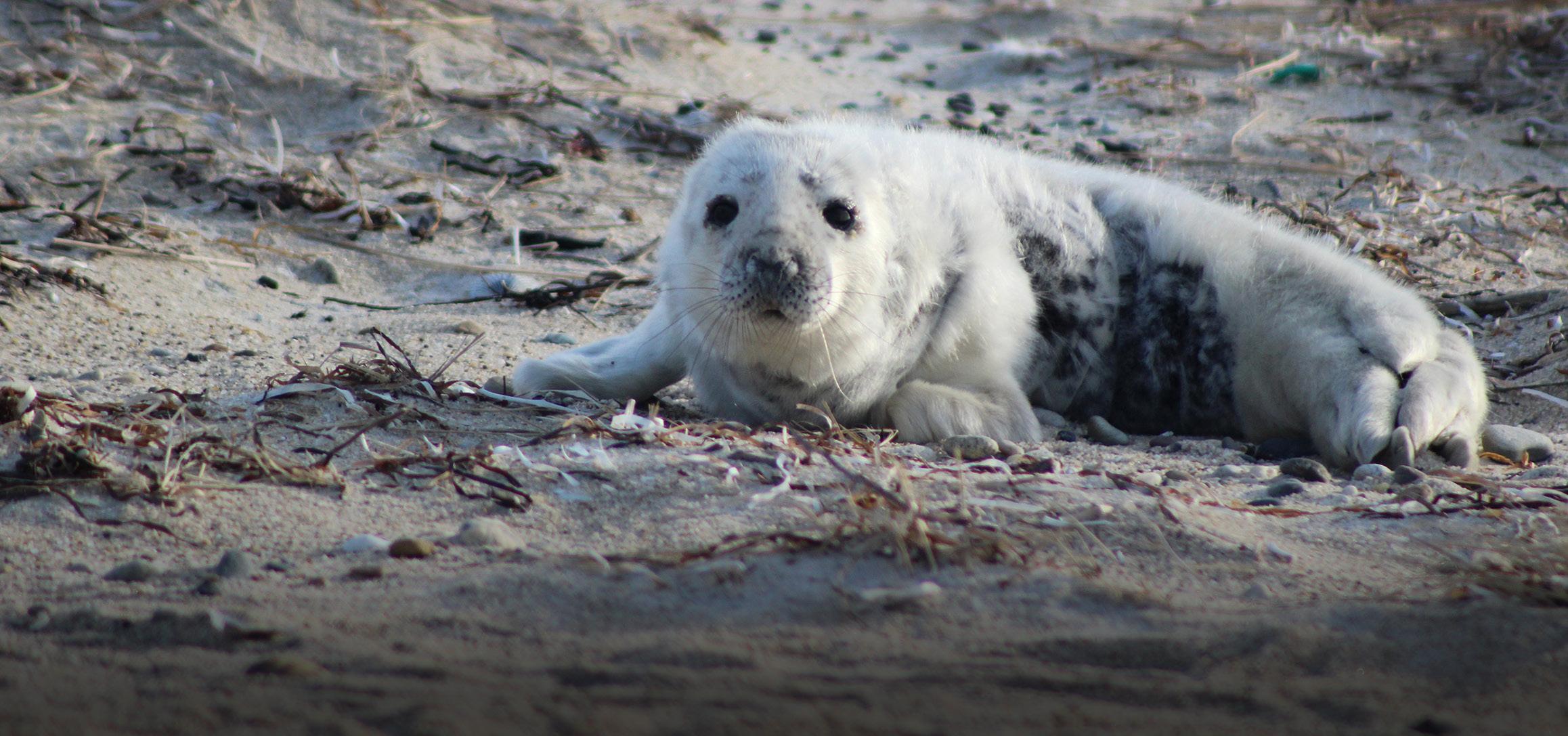
Cormac Collier, President & CEO
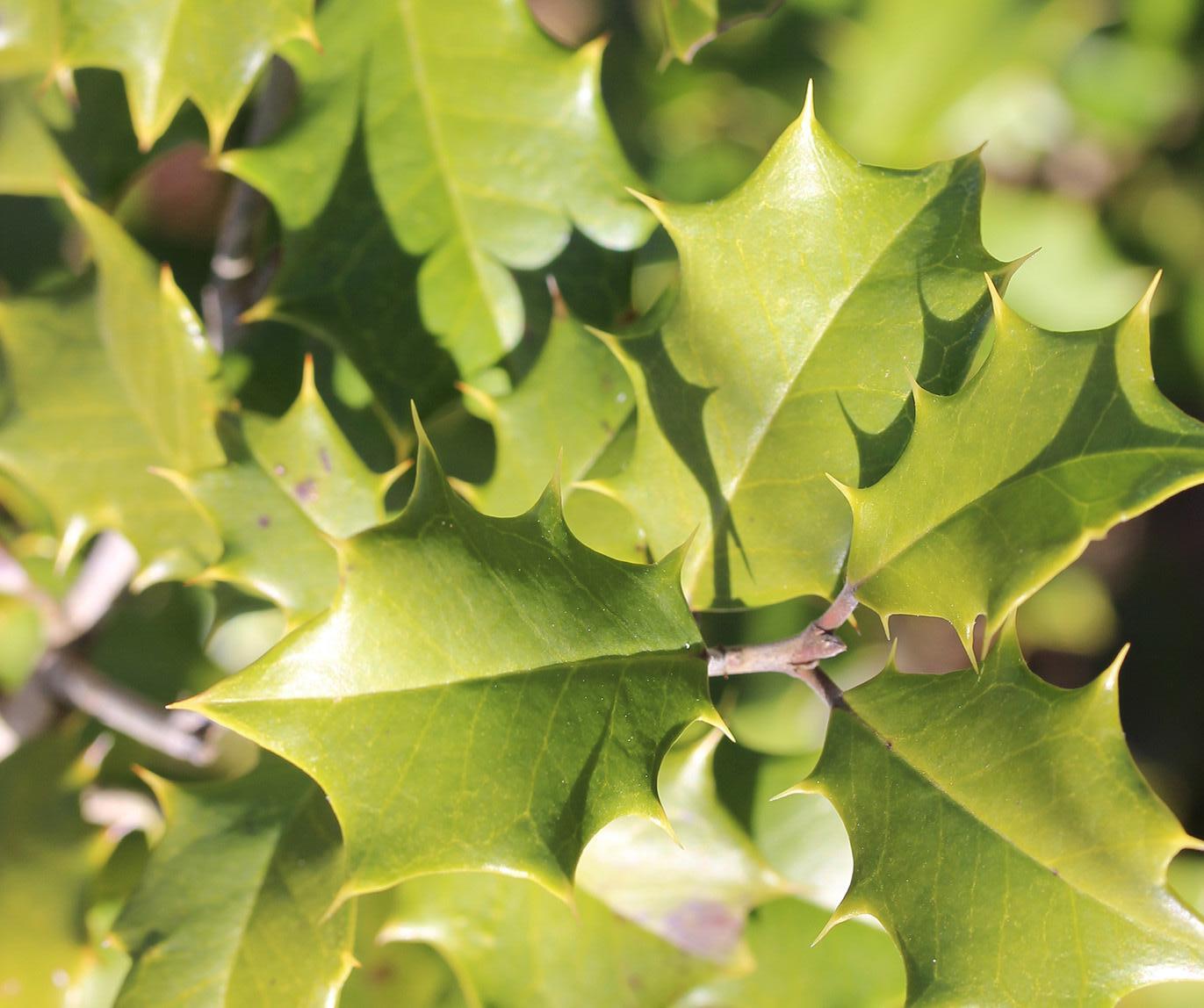



President & CEO
Cormac Collier
Vice President of Science & Stewardship
Karen C. Beattie
Director of Research & Partnerships
Dr. Jennifer M. Karberg
Director of Land Management
Nicholas J. Larrabee
Director of Advancement
Whitney Dayton Brunet
Marketing & Outreach Manager
Allison Levy
Development & Donor Relations Manager
Mara Weiner
Accounting & Administrative Manager Korilynn Adams
Development & Marketing Assistant
Jess Toole
Wildlife Research Ecologist
Danielle O’Dell
Plant Research Ecologist/Botanist
Kelly A. Omand
Interpretive Education Coordinator/Ecologist
Neil P. Foley
Environmental Educator Isaac Hersh
Coastal Ecology Research Technician
Jisun Reiner
Properties Maintenance
Donald J. Mack
Richard H. Mack
Land Management Assistant
Angel Landaverde
Facility Maintenance & Land Stewardship
Technician
Greg St. Aubin
Stewardship Technician/
Wildlife Technician
Gracie Bell
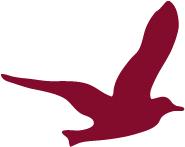

OFFICERS TRUSTEES ADVISORS EMERITUS
Chair
John G. Macfarlane, III
Vice Chair
Todd M. Knutson
Secretary
Lucinda Young
Treasurer
Charles K. Gifford, Jr.
Clerk
Marianne R. Stanton
Assistant Clerk
Mary West
Stephen Bartram
David A. Champoux
Colby Crenshaw
Charles K. Gifford, Jr.
Ande Grennan
Karen Grip
Lindsey Gund
Laura Hanson
Patrick Hehir
Katie Keith
Todd M. Knutson
John G. Macfarlane, III
Jennifer Matthews
James Meehan
Daphne F. Mitchell
Sherwood Newell
Ann B. Oliver
Diane R. Pearl, MD
David Rattner
Marianne R. Stanton
Dr. Geoffrey C. Trussell
Rick Ulmer
Patrick S. Wayland
Mary West
Arthur Gosnell
Isabelle Loring
Richard L. Menschel
Kate Miller
Susan Rein
Jeanne W. Riggs
Susan R. Shapiro
Marcia Weber
Nathan R. Allen, Jr.
John H. Davis
David B. Poor
David Ross
Richard G. Verney
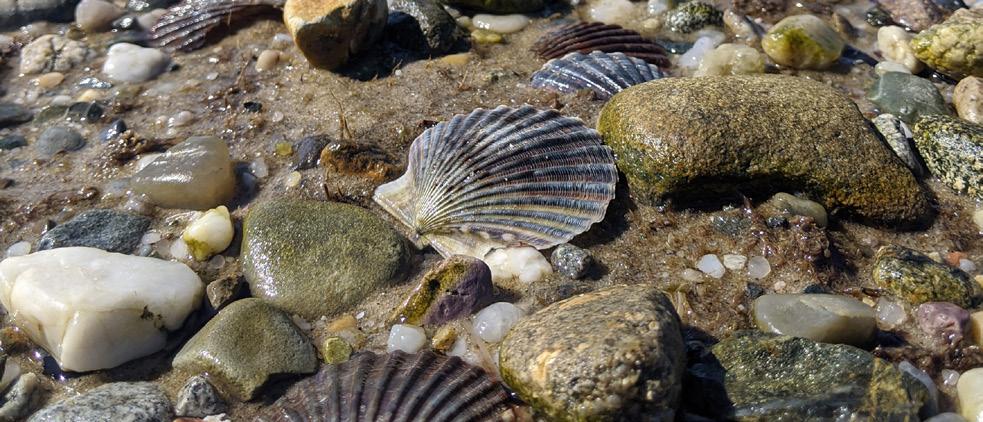


Since 1963, the Nantucket Conservation Foundation, a membership supported, nonprofit conservation organization, has strived to permanently protect many important and beautiful areas of the island for the enjoyment and education of residents, visitors, and future generations. Much of the natural open areas that we associate with Nantucket today will remain protected in perpetuity because of the Foundation’s efforts.
NCF’s newly adopted strategic initiatives provide a roadmap for advancing our mission in this next chapter, including: raising awareness of the Foundation’s endeavors; expanding our ecological and scientific research and restoration initiatives; re-assessing the use of our properties; engaging the wider community through educational and recreational opportunities; initiating new partnerships; informing policy; and elevating the Foundation’s reputation as a leader in conservation and ecology.
NCF launched our strategic planning process in July 2022 with an engaging retreat that brought together staff, trustees, and key stakeholders. A steering committee comprised of staff and Trustees guided the year-long process with small working groups focused on deeply understanding the broader ecological and environmental context on Nantucket and beyond; surfacing new opportunities to advance NCF’s mission; and reimagining the impactful role NCF can play in preservation, conservation, and significant scientific research. Throughout our process, the steering committee updated the Board of Trustees and staff, seeking input and, ultimately, approval for a refreshed mission statement and the articulation of five strategic priorities that will serve as the roadmap guiding NCF forward in the years to come.
The Nantucket Conservation Foundation owns, protects, and stewards over 9,000 acres of land and coastal shoreline, conserves Nantucket’s rare and significant natural resources, and engages in impactful ecological research to inform resource management and further our knowledge of Nantucket’s unique ecosystems and species. We share our environmental expertise with the wider community and provide educational and recreational opportunities to encourage respectful enjoyment and appreciation of our properties.

Continue the opportunistic acquisition of strategically important properties while conserving, preserving, and responsibly stewarding NCF’s 9,000 acres of existing property.
At the heart of all of NCF’s initiatives is our unwavering commitment to preserve our sprawling properties, ensuring that we protect the island’s natural beauty for future generations.
Advance NCF’s reputation as a nationally-recognized leader in ecological and environmental research and restoration programs, utilizing NCF’s properties as a living laboratory surrounded by water.
Develop partnerships with leading individual and institutional researchers whose field of study, goals, and methods align with or complement the Foundation’s goals.

Expand the respectful use of NCF’s properties, showcasing Nantucket’s unique natural ecosystems through year-round educational programming and recreational engagement opportunities.
Support a culture and process to ensure that NCF thoughtfully analyzes, develops, and implements opportunities for expanded community engagement on our properties, while complying with our fiduciary responsibility to preserve the ecological health of our properties, respectfully and sustainably.
Rick Ulmer, Chair, Strategic Planning, Trustee
John MacFarlane, Chair, Board of Trustees
Todd Knutson, Vice Chair, Board of Trustees
Arthur Gosnell, Advisor, Past Board Chair
Daphne Mitchell, Trustee

Cormac Collier, President & CEO
Karen Beattie, VP, Science & Stewardship
Dr. Jennifer Karberg, Director, Research & Partnerships
Neil Foley, Interpretive Education Coordinator & Ecologist
Jim Olney, Land Use Manager
Nick Larrabee, Director of Land Management


Our Land Management team is an integral part of how our organization functions. They tend to the open spaces of Nantucket with care and respect. We would not be as successful in our ecology and habitat management work without the team that implements our scienceminded treatments. Whether springing to action to prevent Southern Pine Beetle from spreading further or thinking ahead to plan more resilient trails, this group of dedicated individuals works hard to advance NCF’s mission.
If you have gone on a walk or bike ride through conservation land and enjoyed Nantucket’s beautiful landscapes, you have this incredible, year-round team to thank for keeping the land accessible. They maintain trailheads and entrances to hundreds of miles in single track trails and sandy roads, staying ahead of overgrowth, and creating new places for pedestrians and bikers to connect with nature.
Nick Larrabee, our Director of Land Management, has a diverse and constantly evolving list of tasks to do. Nick’s solution-focused mindset to whatever problem he’s faced with is admirable, not to mention his work ethic at the Milestone Cranberry Bog.
It helps to have a capable team to rely on. Richard and Donnie Mack bring a wealth of experience to the Foundation. Nantucket born and raised, these two are the backbone of the land management department. Their stories and insight on the island, wildlife, and history is grounding and invaluable. Their hard work and keen eyes toward the land make us better stewards.

We are thrilled to add two new members to our year-round land management team who will help share the load and contribute their skills:
• Angel Landaverde is a Nantucket local who joined us in the summer of 2023. Growing up on island, Angel has a great appreciation for being outdoors, hunting, and riding motorcycles with his family and friends. He has jumped right into some big habitat management projects and has stepped up as an integral and good-natured part of NCF.
• Greg St. Aubin joined NCF this past summer as our seasonal Coatue Ranger, but returned to help us out full time with a multitude of projects and maintenance work. Hailing from Rhode Island and well-traveled, Greg helps to interface between the ecology and land management departments with excellent skills in field ecology, construction, and wood working. His humor and helpful attitude are very much appreciated, along with his problem solving skills.
So many people look forward to experiencing Nantucket’s natural beauty. Whether walking, biking, bird watching, running with their dog, or sitting still outside; Foundation properties are the happy place and space where they feel safe to connect with the world around them. These hard-working land managers transform their commitment to our mission into tangible benefits for the community.

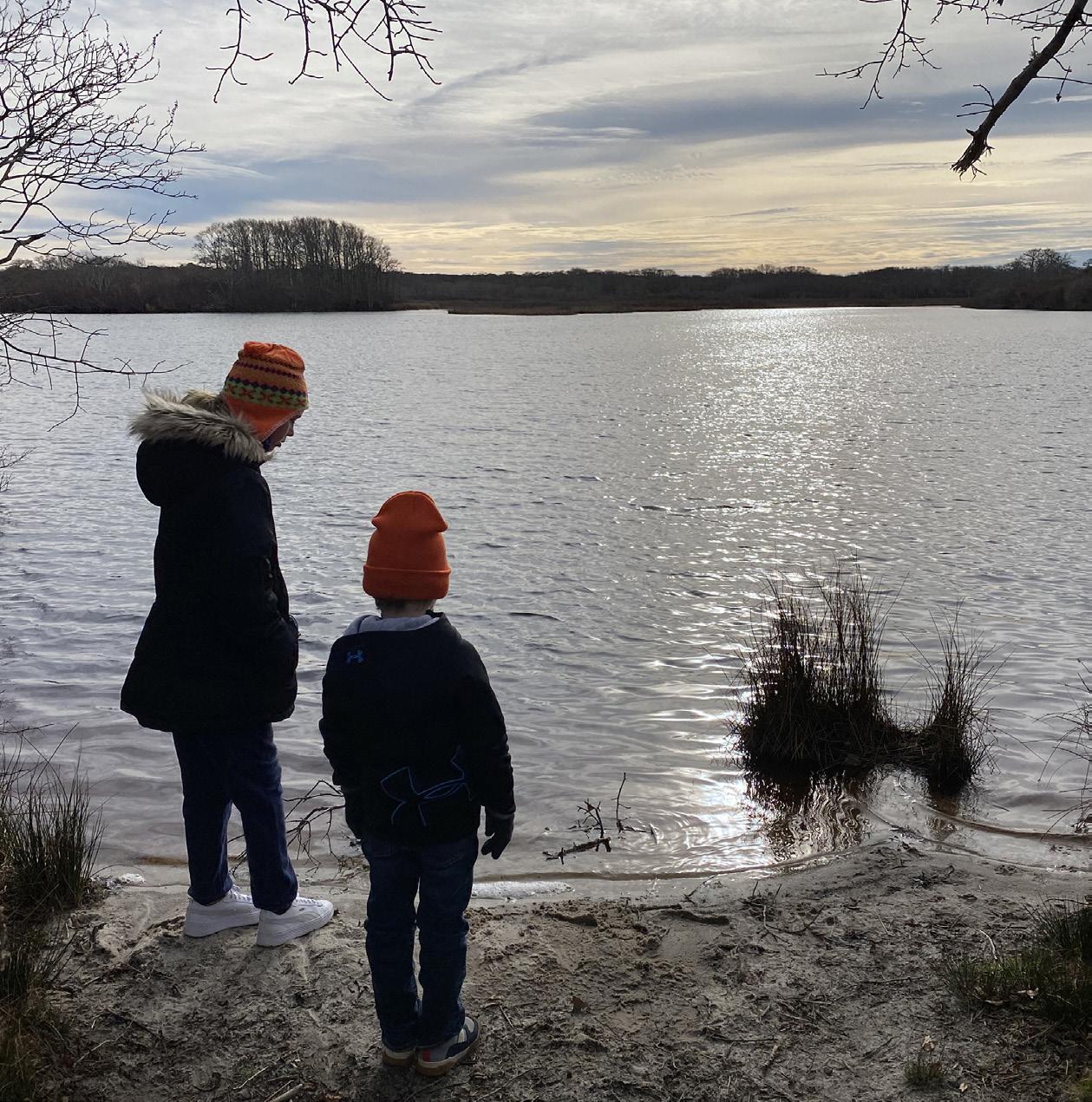




Todd is a life-long seasonal resident with his mother, Carolyn Knutson, who first came to the island when she was in college. Todd joined The Foundation’s Board in 2016, taking after his mother who was an active Board member in the 1990s. Since joining the Board, Todd has chaired multiple committees, drummed up inspiring support, and created our Trails Fund for the continued improvement of the NCF trail network. Todd now serves as the Vice Chair of our Board, rallying involvement and guiding our strategic initiatives. He still loves going on regular walks in Ram Pasture and mountain biking through the Moors, even accomplishing the Coast-to-Coast Trail on his Mountain Unicycle (you read that right). We are happy to have Todd’s commitment and hustle to champion our mission.
Originally from upstate New York, Neil is a graduate of the State University of New York College of Environmental Science and Forestry. He first came to Nantucket in April 2014 to serve as the Coatue Ranger & Shorebird Monitor, a job he held for six summers as he completed his Master’s Thesis studying the Double-crested Cormorants nesting on Coatue. Now Neil is approaching 5 years in his current role, leading programs and organizing education opportunities for the community to engage with our mission. He has expanded and diversified our community outreach and offerings including Winter Walks, Free Community Yoga, and the Coast to Coast Trail Senior Series. His enthusiasm, knowledge, and humor keep attendees of his walks coming back to learn more.
Along Milestone Road on the way out to Sconset, the old Nantucket commons were grazed by thousands of sheep throughout the 1700s and 1800s. The Foundation began acquiring these parcels along Milestone Road in 1972, but the property gained the name The Serengeti once habitat restoration work began here in the 1990s, allowing sandplain grasslands to thrive once more. The name Serengeti means “Endless Plains” in the Maa language of Kenya and Tanzania. The name is fitting for the sprawling grassland here dotted with Sassafras Trees whose shapes are reminiscent of the Acacia trees of Africa. In keeping with past tradition, cutouts of exotic animals created by Mike Girvin’s Woodshop Class and the NHS Art Studio are installed to mark the start of the Nantucket summer season around Daffy Day.
This native bivalve has a wide distribution and is cultivated for its delicious, briny taste and polarizing texture. An adult oyster filters about forty gallons of water per day, actively improving water quality as they sit and siphon. Oyster larvae in their veliger stage swim freely and use taste and smell to find their way to other oysters that they can grow on. They will attach themselves to many different hard surfaces to begin forming a reef. With the help of the Town of Nantucket’s Natural Resource Department, we created an artificial Oyster Reef comprised of hard Oyster Castle Blocks with oyster shells ground into the matrix that were inoculated with oysters by the Brant Point Hatchery Team. The Artificial Reef has spent over two years filtering and providing habitat in Polpis Harbor for a huge diversity of species while protecting a vulnerable tidal creek and bank saltmarsh.
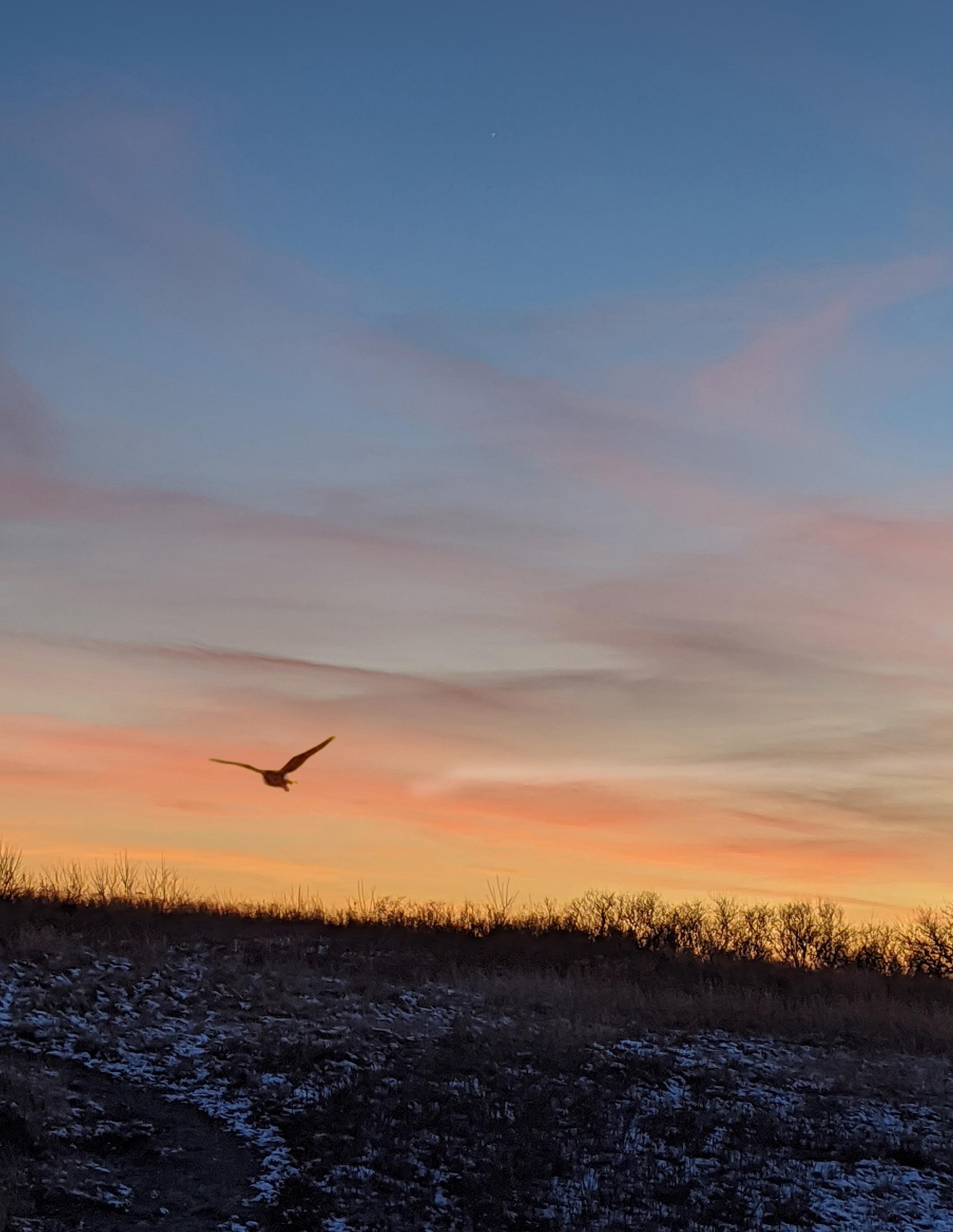
The Nantucket Conservation Foundation relies upon independent contributions from individuals who value the island’s natural beauty and its future. Your support allows NCF to protect the 9,000 acres of land, 100 miles of trails, and 17 miles of coastline it owns and stewards, to conserve Nantucket’s natural resources, and to engage in impactful ecological research. Each and every gift makes a difference. Thank you for joining us in our work to preserve Nantucket’s fragile and beautiful environment.


Scan to support the Nantucket Conservertion Foundation



Years of research, monitoring, engineering plan development, permitting, and grant writing came together in January 2024, when NCF and its partners broke ground on our Windswept Bog Wetland Restoration project. Since 2019, NCF has been working with the Massachusetts Division of Ecological Restoration’s Cranberry Bog Program (DER) to plan a watershed-level wetland restoration for this former cranberry farm property, located off Polpis Road in the northeastern portion of the island. We are now finally in the process of implementing this project, which is being funded by DER and generous grants from the Southern New England Estuary Program (SNEP) Watershed Implementation Program, The Richard King Mellon Foundation, and the U.S Fish and Wildlife Service National Coastal Wetlands Conservation Grant Program.
NCF is extremely grateful to our project team members who worked so hard to get us to this stage: Jessica Cohn from DER and Michael Soares and Dr. Julianne Busa from Fuss & O’Neill, Inc. engineers. We are contracting with SumCo Eco-Contracting, a firm that specializes in ecological and environmental improvement projects with experience restoring wetlands at other retired cranberry bogs in Massachusetts. The restoration work at Windswept is scheduled to take place over 2-3 years, with construction activities happening only during the winter dormant season (from November to mid-March) to avoid impacting rare plants, nesting birds, and breeding wildlife on the property.
Restoring naturally functioning wetlands on retired cranberry bogs provides many important ecological benefits. Negative impacts from past cranberry

farming on this property include: a sand fill layer placed over native wetland soils; lateral and perimeter ditching; berms, water control structures, and straight, unnatural water flow paths. The cumulative effect of these alterations is altered hydrology, drier soils, and a trajectory toward more upland plant species over time. When this takes place, there is a loss of wetland “ecosystem services” – the beneficial things that wetlands do for the environment such as water quality improvement, flood water storage, and fish and wildlife habitat.
Key goals of this project are designed to “unwind” these negative impacts and include:
• Restoring wetland flow and connectivity
• Creating natural gradients between restored wetlands and surrounding uplands
• Maintaining and establishing valuable plant and wildlife habitats
• Perpetuating and enhancing public access, use, and enjoyment of the property
• Maintaining Stump Pond (a unique but humanmade wetland created to serve as a reservoir for the cranberry operation back in the early 1900’s)
• Maximizing the restored wetland’s ability to filter excess nutrients to improve water quality in Polpis and Nantucket Harbors
Construction this winter is taking place in the southwestern and northeastern portions of the property and will then proceed to the center and property entrance areas in subsequent years. The process of restoring a wetland is like painting the floor of a room – the work needs to begin in the corners and

then proceed towards the center. Work currently taking place includes removing the sand layer placed over many years of cranberry farming operations, using this material to fill in perimeter and lateral ditches, excavating the center portions of the former bog cells to intersect the ground water and create sloping topography, removing berms and water controls structures to create an interconnected wetland system, and constructing strategically-located boardwalks over the restored wetlands to maintain public access across the site.
During the next several months, the property will look very much like a construction zone. However, as the growing season begins later this spring, we expect rapid regeneration of vegetation within the restored wetlands, based on the results of similar projects completed elsewhere in southeastern Massachusetts. The seeds of wetland plant species can lie dormant for many years, waiting for the right climatic and soil moisture conditions to reestablish. Over the coming summer, we expect to see the regeneration of native plants that occurred on this property prior to the development of the cranberry farm in the early 1900’s.
We are looking forward to showcasing the results of this exciting, keystone project that fulfills our habitat restoration goals and serves as a model for similar projects across southeastern New England. We hope that you can join us for one of several project tours that we are planning for this upcoming season to see first-hand the results of this work!

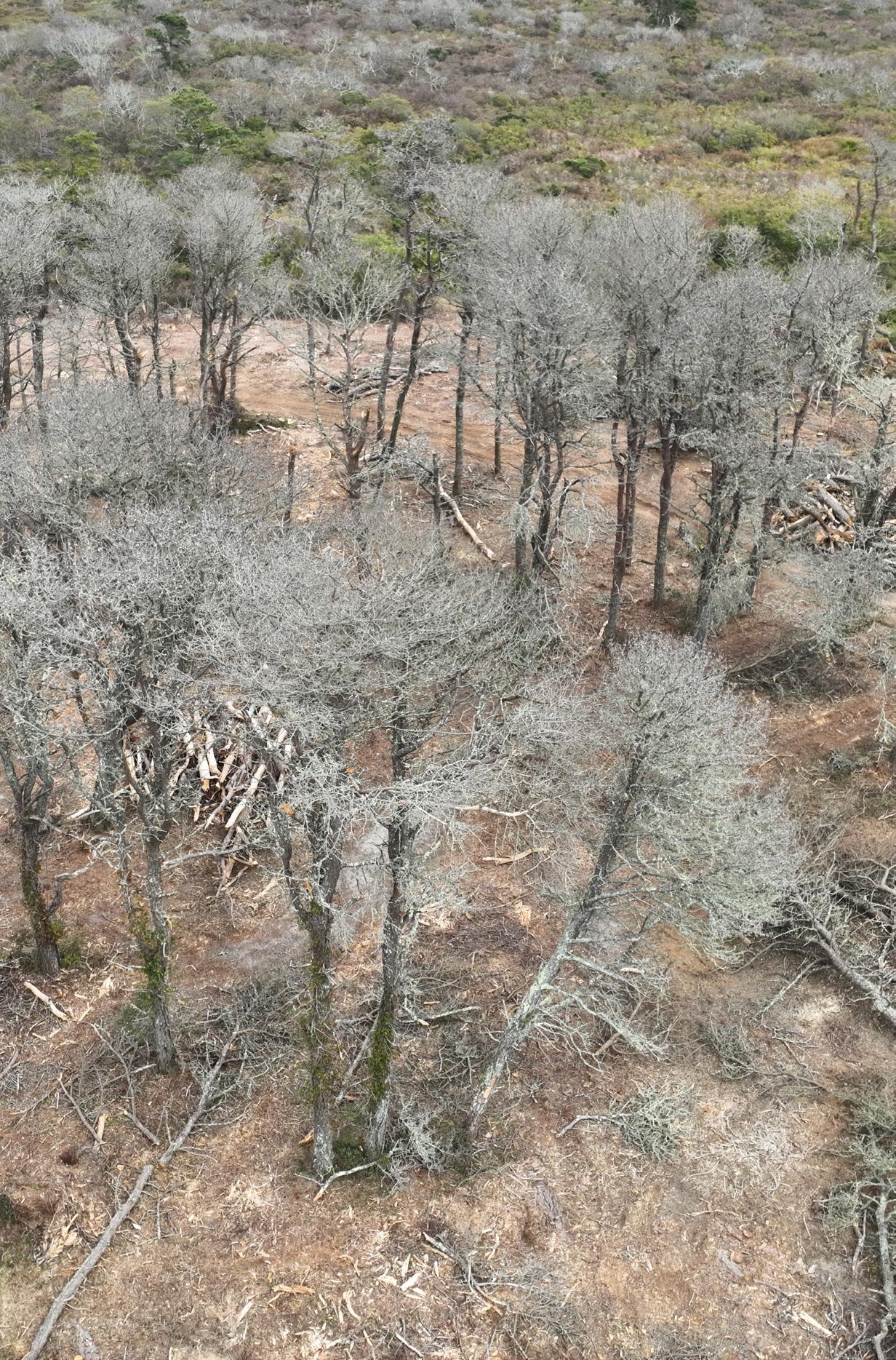
After many months of forest management work at the West Gate of Ram Pasture to tamp down a southern pine beetle outbreak, we are holding our breath as the cold temperatures keep the beetles dormant until the spring. This outbreak, originally discovered in July 2023, has transformed the face of this property, and caused a temporary closure of one of our most popular walking trails on the island so that we could operate heavy machinery safely. The parking lot and most of the trails at West Gate were reopened to the public on December 11, but additional closures could occur as we reassess and remain vigilant for future outbreaks.
The forest doesn’t look the same but that’s not necessarily a bad thing. We removed over 220 pitch pine trees infested with southern pine beetle. Some of those trees were estimated to be nearly 180 years old! We were able to leave standing many of the trees that were already dead when we found the outbreak to provide great wildlife habitat for other insects, birds, and bats.
There are a few other silver linings – the birds were quite happy. We’ve seen huge numbers of woodpeckers, brown creepers, pine warblers and kinglets flitting through the remaining live and dead pines. Northern long-eared bats abandoned the forest, but we detected more calls of migratory bats (red, silver-haired, and hoary bats) than we’d ever seen there before. Prior to this management, there was no regeneration of pitch pine in this forest because of the overgrown understory. Clearing it out allows for sunlight to reach the forest floor, which will

promote growth of juvenile pitch pines and other desirable grassland and heathland species. There is great potential now for NCF to manage this forest and try novel restoration techniques.
Managing this insect outbreak was expensive, time and labor intensive and it was devastating to see the impacts to this forest. However, it was the right thing to do. Doing nothing and “letting nature take its course” wasn’t a responsible option as it would eventually have spread to other pitch pine forests on both public and private land. A few other infected trees around the island have been quickly removed, and a significant amount of proactive management is planned or underway by NCF, the Nantucket Land Bank, and MassAudubon. We are still likely to see future outbreaks, but this certainly slowed down that possibility at Ram Pasture and gave us and our conservation partners on island a chance to live and learn from this experience so that we are better prepared and equipped to respond in the future.
We need help from the public to prevent future outbreaks like this one from getting out of control, especially as spring approaches. We ask that anyone who regularly walks in pine forests becomes familiar with the signs of beetle infestation and report! We have scheduled an upcoming walk on Saturday April 13 so the community can see the problem and learn the signs to look for. With the distribution of pine trees across Nantucket, the more engaged citizens we have paying attention, the better we can keep ahead of the problem.


Scan here to learn more about recognizing the signs of the Southern Pine Beetle


Free, open to the public. Sign up at www.nantucketconservation.org/events
February 24 - Masquetuck
Travel the short loop through a small, fascinating hardwood forest that extends to the shores of West Polpis Harbor with opportunities to see winter ducks, talk shellfish, and observe other residents of this ecologically rich area.
March 2 - Ram Pasture
Visit Ram Pasture to see how winter settles into the glacial outwash plain. Move your feet with other year-rounders and observe the changes happening due to Southern Pine Beetle.
March 16 - Squam Farm
A winter favorite! Walk with us through the sheltered paths and open pastures in this hidden gem. Learn about the trees in Nantucket’s regenerating hardwood forest and the creatures that can reside here all winter.


Our watershed-level restoration project at Windswept Bog is underway! Be among the first to explore these retired bogs after phase one construction and before the 2024 growing season. See the work done so far, understand the transitional journey of this property, and hear the plans for phase two.
An important and targeted walk to observe the effects of Southern Pine Beetle infestations up close. Learn the signs to look for and understand the significant impact this southern species could have on our island forests.
A new guided walk experience to a lesser-known hill in the Moors with a spectacular view. Not as easily findable as Altar Rock, but it holds a higher elevation and the experience is worth the hike through the sandy roads of the Eastern Moors.
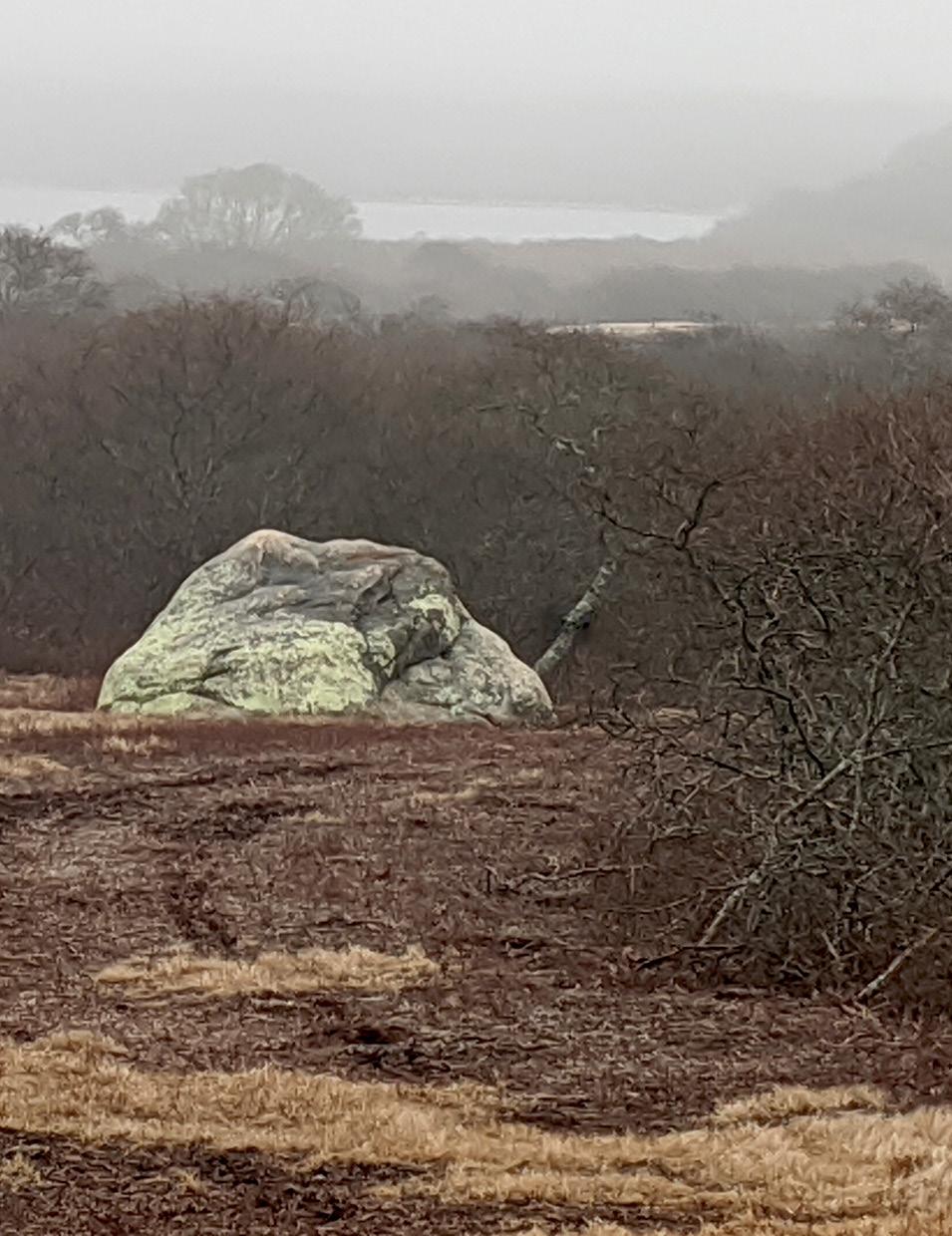

Do you know someone who cares for Nantucket as much as you do? A gift membership to the Foundation is a great way to celebrate your shared commitment to preserve open spaces and natural habitats for rare and endangered species on the island. Each membership comes with a subscription to the Foundation’s newsletter and publications, property map, membership decal, and invitations to the Mornings for Members and Ecology Excursions throughout the year. To gift a membership, scan the flowcode below or visit our website at www.nantucketconservation.org/ support